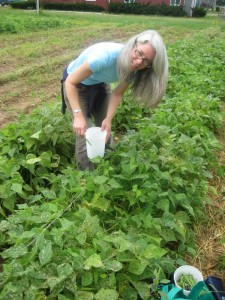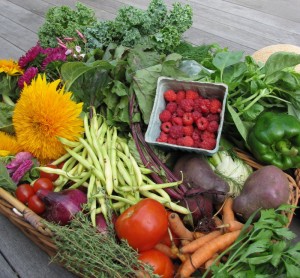 The hour I spend picking green beans, sunflowers, and cherry tomatoes at my CSA (Community Supported Agriculture) is the most blissful hour of the week. I usually arrive at the farm around noontime on Tuesdays. The sun is high and hot, and the little ache in the small of my back as I crouch low to hunt for beans reminds me that I’m not in the greatest shape. Some days, as I trek back to the farm stand to collect the rest of my share, my boots squish-squish through deep muddy trenches left behind after a recent deluge. Back home, I find my jeans caked with dirt, pollen, and grass stains. I have Humid Hair, stupidly unbehaving. I am happy.
The hour I spend picking green beans, sunflowers, and cherry tomatoes at my CSA (Community Supported Agriculture) is the most blissful hour of the week. I usually arrive at the farm around noontime on Tuesdays. The sun is high and hot, and the little ache in the small of my back as I crouch low to hunt for beans reminds me that I’m not in the greatest shape. Some days, as I trek back to the farm stand to collect the rest of my share, my boots squish-squish through deep muddy trenches left behind after a recent deluge. Back home, I find my jeans caked with dirt, pollen, and grass stains. I have Humid Hair, stupidly unbehaving. I am happy.
I unpack my treasures and focus for another hour on washing greens, arranging flowers, rearranging the refrigerator, hauling stems and trimmings to the compost pile. Work like this is so engrossing that it is impossible to entertain the usual distracting conversations in my head. I relax without knowing it. Beans are piling up, so I decide to “put some up” – the expression my grandmother used for freezing vegetables for the winter. It has taken me 47 years and a mid-life course-change to do something she did every summer of her adult life. I put the beans in boiling water for 2 minutes, transfer them to an ice bath, let them dry, spread them out on sheet pans to freeze, and pack them away in freezer bags.
I know I won’t be able to eat those ripe tomatoes fast enough, either, so I decide to roast them, long and slow and drenched in olive oil. After only a few minutes of prep, the tomatoes take care of themselves while I get back to work at my computer. In a few hours, what emerges from the oven is something so deeply caramelized, so unctuous in texture, and so beautiful (in a decidedly rustic way), that it is hard not to eat them all instead of popping them in the freezer. (Check out my recipe for roasted tomatoes on finecooking.com.)
My CSA experience has been so pleasurable, that—typical me—I’ve lately been wanting the whole world to get in on it, too. (Find a CSA near you.) Why not? The usual argument against sustainable food is that it costs too much; but for once, I get to poke a little tiny hole in that argument. My CSA share (which I pay directly to the farmer before the season gets going so he has operating money upfront) is a bargain. I opted for a small share for the full season – $465 for 24 weeks – which averages out to a little more than $19. (If I had opted for just a 10-week share, it would have been about $25).
 Last week, this is what I got in my small share: ¾ pound potatoes, ¾ pound baby carrots, ¾ pound tomatoes, ½ pound red onions, ½ pound green beans, ½ pint raspberries, 4 beets, 1 green pepper, 20 cherry tomatoes, 1 fennel bulb, 10 kale leaves, 1 large bunch fresh basil (with roots), 1 small bunch thyme and parsley, 1 head lettuce, 1 cantaloupe, ½ bag mixed salad greens. Plus: 6 sunflowers, and 1 large bunch mixed flowers.
Last week, this is what I got in my small share: ¾ pound potatoes, ¾ pound baby carrots, ¾ pound tomatoes, ½ pound red onions, ½ pound green beans, ½ pint raspberries, 4 beets, 1 green pepper, 20 cherry tomatoes, 1 fennel bulb, 10 kale leaves, 1 large bunch fresh basil (with roots), 1 small bunch thyme and parsley, 1 head lettuce, 1 cantaloupe, ½ bag mixed salad greens. Plus: 6 sunflowers, and 1 large bunch mixed flowers.
Just for kicks, I priced out this same list of ingredients at a national chain grocery store. Even though the produce looked so dismal that it could have been picked in the last millennium, the total still wound up being more than the CSA: $30, without the flowers. And you can bet very little of that $30 (unlike all your CSA dollars) is going directly to farmers.
I know this is just one needle-in-the-haystack example, that local and organic food is still generally more expensive than conventionally grown food. (Expensive, that is, dollar-wise, though much more economical in the long run when compared to the health, safety, waste, and fuel costs associated with “cheap” food. But for the sake of argument, what if it weren’t all about money? What’s the impediment? Scrolling back up to the top of this blog, you can see the answer in black and white: Time and convenience. Joining a CSA is a commitment, and a bit inconvenient. I probably spend two to three hours every Tuesday gathering, washing, and storing vegetables. Sometimes I spend more time than that preserving food I know I won’t be able to eat in the week. And then, of course, I’m committed to cooking dinner at home most nights—dinner that always has fresh vegetables in it. But, ironically, those hours I spend and those meals I prepare are also the relaxing, delicious, and gratifying rewards that make my life better, simpler, sweeter. Without making the commitment, I might never have known.
This post originally appeared on The Huffington Post Green page, on September 3, 2009.

One thought on “The True Cost—and Reward—of Fresh Food: Time Well Spent”
Comments are closed.